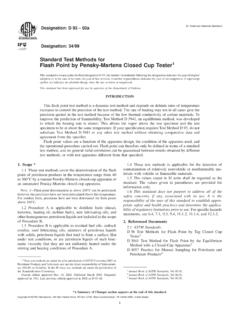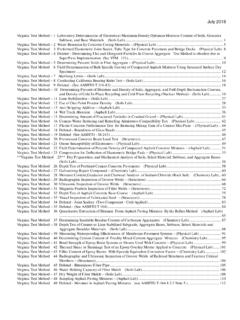Transcription of Reference Manual: Flow Test Data Book and Flow Handbook ...
1 Reference Manual00821-0200-4810, Rev BAMay 2014 Flow Test Data Book and Flow Handbook for Wet Gas Flow Measurement with Conditioning Orifice MeterReference manual 00809-0100-4021, Rev GCTitle PageMay 2014iiiFlow Test Data Book and Flow Handbook for Wet Gas Flow Measurement with Conditioning Orifice Meter Emerson Process Management satisfies all obligations coming from legislation to harmonize product requirements in the European this manual before working with the product. For personal and system safety, and for optimum product performance, make sure to thoroughly understand the contents before installing, using, or maintaining this Central1-800-999-9307 (7:00 to 7:00 CST)National Response Center1-800-654-7768 (24 hours a day)Equipment service needsInternational1-(952) 906-8888 The products described in this document are NOT designed for nuclear-qualified applications.
2 Using non-nuclear qualified products in applications that require nuclear-qualified hardware or products may cause inaccurate information on Rosemount nuclear-qualified products, contact an Emerson Process Management Sales Manual00821-0200-4810, Rev BATitle PageMay 2014vReference manual 00821-0200-4810, Rev BATable of ContentsMay 2014Ta b le of Co n tent sContents 1 Section 1: 405C Compact Conditioning Orifice Plate and 1595 Conditioning Orifice Features .. Testing .. Testing .. Testing .. Specifications..2 2 Section 2: Theory of .. Detail .. Conditioning Orifice Meter Technology..6 3 Section 3: Test Facilities and Flow .. Laboratories .. tests ..8 4 Section 4: Flow 405C and 1595 Conditioning Orifice Plate.
3 Values and Variables Designations .. Calculation Tables..30 5 Appendix A Additional GraphsRosemount 1595 Calculated offset from measured versus Lockhart-Martinelli Number..33 Rosemount 405C Calculated offset from measured versus Lockhart-Martinelli Number..33 CEESI Facility Diagram..34viReference Manual00821-0200-4810, Rev BATable of ContentsMay 2014 Table of Contents1 Reference manual 00821-0200-4810, Rev BASection 1: 405C Compact Conditioning Orifice Meterand 1595 Conditioning Orifice PlateMay 2014 Section 1405C Compact Conditioning Orifice Meter and 1595 Conditioning Orifice PlateProduct features .. page 1 Testing .. page 2 Product specifications .. page featuresThe Rosemount 405C Compact Conditioning Orifice Meter and 1595 Conditioning Orifice Plate primary flow elements maintain the traditional strengths of orifice plate technology with improved features / strengths of the 405C include: More economical than a Traditional Orifice Plate Installation Accurate and repeatable Short straight run requirements Self centering mechanism Based on ASME/ISO Corner Tap DesignThe strengths of the 1595 include: Based on the most common primary element in the world with established standards for manufacture and installation.
4 Easy to use, prove, and troubleshoot Accurate and repeatable Short straight run requirements Based on ASME/ISO/AGA StandardsThe 405C and 1595 Primary Flow Elements are sized using Rosemount's Instrument Toolkit sizing program. This program provides accurate flow calculations using installation details and fluid properties for the flowmeter and presents this on a calculation data sheet or specification Manual00821-0200-4810, Rev BASection 1: 405C Compact Conditioning Orifice Meter and 1595 Conditioning Orifice PlateMay performed on the 405C / 1595 Primary Flow Elements are divided into two major categories: Mechanical and structural testing Independent laboratory testingAll categories are on going and continue to be a part of the current Rosemount test program for the 405C / 1595 Primary Flow testingRosemount performed integrity testing for.
5 Allowable stress limits Hydrostatic pressure Thermal effects VibrationAt the following labs: Hauser Laboratories, Boulder, CO Rosemount Vibration Laboratory, Eden Prairie, MN testingRosemount 405C and 1595 Primary Flow Element models were tested in wet gas conditions at the following independent laboratories: Colorado Engineering Experiment Station, Inc. (CEESI)Certified flow-data sheets were supplied from each of these facilities. Representative samples of tests conducted at the independent laboratories are in Section 3: Test Facilities and Flow specificationsThe above testing has enabled Rosemount to provide product which conforms to the following specifications in wet gas applications. See Appendix A for graphical representations of how well the curve fit matched the actual 1-1.
6 Rosemount 405C Compact Conditioning OrificeBeta ratioDischarge coefficient uncertainty = = = manual 00821-0200-4810, Rev BASection 1: 405C Compact Conditioning Orifice Meterand 1595 Conditioning Orifice PlateMay 2014 Table 1-2. Rosemount 1595 Conditioning OrificeBeta ratioDischarge coefficient uncertainty = = = Manual00821-0200-4810, Rev BASection 1: 405C Compact Conditioning Orifice Meter and 1595 Conditioning Orifice PlateMay 20145 Reference manual 00821-0200-4810, Rev BASection 2: Theory of OperationMay 2014 Section 2 Theory of OperationOverview .. page 5 Technical detail .. page 5 Conditioning orifice meter technology .. page Rosemount 405C and 1595, based on orifice plate technology, is a device used to measure the flow of a liquid, gas, or steam fluid that flows through a pipe.
7 It enables flow measurement by creating a differential pressure (DP) that is proportional to the square of the velocity of the fluid in the pipe, in accordance with Bernoulli's theorem. This DP is measured and conver ted into a flow rate using a secondary device, such as a DP pressure transmitter. The flow is related to DP through the following 1where:Q = Flow rateK = Units conversion factor, discharge coefficient, and other factorsDP = Differential pressureFor a more complete discussion on the flow equation, refer to Section 4: Flow detailAs stated previously, traditional orifice plate flowmeters are based on Bernoulli's theorem, which states that along any one streamline in a moving fluid, the total energy per unit mass is constant, being made up of the potential energy (the pressure energy), and the kinetic energy of the fluid.
8 Where:where:P1 = Upstream pressureP2 = Downstream pressurep = DensityV1 = Upstream velocityV2 = Downstream velocityWhen fluid passes through the orifice the velocity of the fluid through the orifice increases. This increase in fluid velocity causes the kinetic energy of the fluid immediately downstream of the orifice plate to increase, while simultaneously decreasing the static pressure energy of the fluid at that same point. By sensing the static pressure on the upstream and downstream sides of the orifice plate, the fluid velocity can be V12+P212--- V22+=6 Reference Manual00821-0200-4810, Rev BASection 2: Theory of OperationMay 2014 Some assumptions were made in deriving the theoretical equation, which in practice are not valid: is conserved in the flow stream.
9 Taps are at ideal locations. profile is flat. These items are corrected by the discharge coefficient which is derived from experimental data and is different for each primary Coefficient C = orifice meter technologyThe Rosemount 405C and 1595 Conditioning Orifice Plate has the added advantage of being able to operate with reduced straight run requirements. With its multiple orifices in the flow stream it is much less susceptible to velocity profile distortion, swirl, and secondary flows. If the velocity profile is skewed, each of the orifices will conduct a part of the total fluid flow within the pipe. The fluid pressure on the downstream side of the conditioning plate that is attributable to each of the separate orifices will be averaged within the fluid to provide an average downstream pressure.
10 The average downstream pressure is compared with the upstream pressure to provide an average differential pressure for whatever velocity profile is presented to the multiple orifice plate, resulting in an accurate measurement of the rate of fluid flow in the mentioned in an earlier section, every 405C and 1595 is flow calibrated as part of the manufacturing process. The purpose of this calibration is to determine a calibration factor which is applied to the flow calculations as an adjustment to correct for bias error from the ISO-5167 discharge coefficient equations. This results in an accurate flowmeter which conforms to the ISO-5167 Theoretical 7 Reference manual 00821-0200-4810, Rev BASection 2: Test Facilities and Flow TestsMay 2014 Section 3 Test Facilities and Flow TestsOverview.














